 |
The Saint of the Day
St. Macrina the Younger – July 19
Prof. Plinio Corrêa de Oliveira
Biographical selection:
Macrina was born in 327 in Cesarea, the eldest child of Basil and Emmelia. She was the granddaughter of St. Macrina the Elder and sister of St. Basil, St. Gregory of Nyssa, and St. Peter of Sebastea. Her mother based herself on the Book of Wisdom of Scriptures to raise her children, and used to chant the psaltery with them.
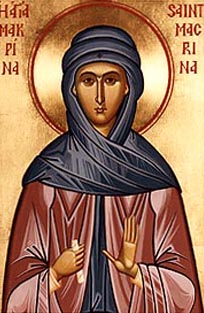
St. Macrina the Younger
|
At age 12, Macrina was engaged to be married, but when her fiancé died, she decided she would not marry. She dedicated her life to help raise her brothers well and to assist her mother. After her siblings had grown up and were completely formed, they used to call her Macrina the Great, as they had in their childhood, a sign of the high respect they had for her.
When she became gravely ill and was close to death, St. Gregory of Nyssa went to see her. He found her laying on a wood board and wearing a hair-shirt. He carefully lifted her and placed her on a bed. The dying woman, seeing her last hour was at hand, remembered all the good things God had given her during her lifetime and gave glory to Him. She said:
“Oh, Lord! Thou didst destroy the fear of death. Because of Thy sacrifice, true life begins when the present life finishes. We will sleep for a while and then, to the sound of the trumpet, we will resurrect. Thou didst save us from the curse of the sin, redeeming us from both sin and its curse.”
Kissing an iron Crucifix that held the relics of the Cross of the Savior, which she always had close to her, St. Macrina serenely died in the year 379. She was buried beside her parents.
Comments of Prof. Plinio:
This selection appears a bit sparse, since it only tells us the names of her parents and brothers, and that she helped to raise the latter. Afterward, she died piously.
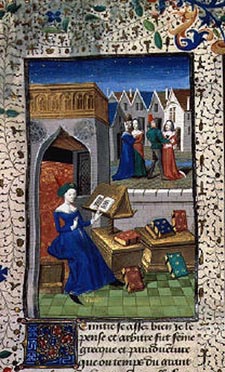
A lady enjoying the harmony of her home garden - Recueil de miniatures, 15th c
|
Let me see if this sparseness can be filled with some considerations on the feminine life suggested by the life of St. Macrina.
Until the explosion of the feminist movement in the post-World War I era, there was an idea about the feminine lifestyle that we should conserve and emphasize, above all in this epoch when the disgusting unisex way of life has been accepted.
This idea is born from a most elementary truth: Woman and men are very different, even if both are part of the same human genre. Therefore, they have different roles in life.
It is proper for the man to provide for the needs of the family and to work to earn sufficient means for that. For the woman it is proper to stay inside the home and provide for man a warm and ordered house, a true treasure.
That is, the woman should bear his children and raise them well. After the children’s education is complete and they have married, the role of the woman is to be the natural center of the family. Her home becomes the meeting point for the children and grand-children. Therefore, it is normal that she spends her life inside the home.
I am not saying that the woman should live in a kind of Muslim harem, never going out. But I am supporting the idea that to go out everyday is not proper for a lady with an authentic feminine spirit. The place where a woman finds her entertainment and completes her personality is her own home. As an extension of it, she also visits the homes of her close relatives and special friends. She should visit them often, but not everyday.
What should the lady do inside her home? She should be receiving her children and grandchildren, taking care of the home, leading a calm and serene life, and praying. The nature of a woman calls for recollection, calm, and tranquility.
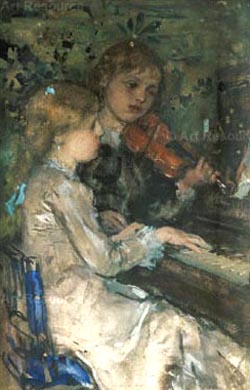
The recollection of a well-formed home allows a proper formation for children -The Duo, painting by Jacob Maris
|
While the nature of a man calls for him to go outside the home, to engage in
activities and battles, the nature of a woman asks for this recollected lifestyle. This kind of life offers circumstances for her to save her soul and become a saint.
Until the feminist movement, this was the traditional way of being for women.
It was normal for ladies to not leave their homes. They went out to go to Sunday Mass and make some visits. The daughters who wanted to marry used to go out a little more, often for shopping or for some infrequent and very respectable party. Otherwise, their normal life revolved around the home.
This way of life permeated with calm and piety could lead a lady with the proper spirit to a high level of sanctity. At any rate, this tranquil lifestyle tended to lead to the formation of solid feminine virtue, which made the woman the moral axis of the entire family.
You can see that this most probably was how St. Macrina lived. She accomplished her mission on earth by helping to raise three saints for the Church and transmitting to them the education she received from her parents, who were also saintly. She was, therefore, a kind of funnel through which sanctity passed from two reservoirs of sanctity to three others.
She stayed at home, leading a normal life, taking care of the house, cooking, directing the servants, and dedicating a good part of her time to prayers. She did all this with a supernatural spirit and became a great saint.
She is, for that reason, a model to those ladies who should live normal holy lives. She also represents the opposite of the frenetic agitation of today’s lifestyle that is contrary to the feminine spirit.
The selection showed how the end of her life was crowned with many graces:
First, it was crowned by the presence of St. Gregory of Nyssa who assisted her in her last moments.
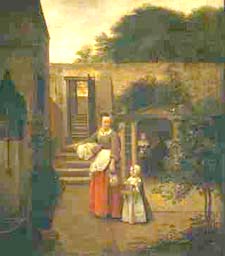
The calm life of times past is in this courtyard scene by Pieter de Hooch
|
Second, she spoke those beautiful words before dying. They were words of faith, of a person who knew that her life was not truly ending, but that her body would resurrect from its ashes at the end of the world. She also had confidence in Divine Mercy that she would be received in Heaven.
Third, she died with the consolation of having a Crucifix with a relic of Our Lord’s Cross in her hands.
The goal of Christian Civilization, from a certain point of view, is to create a state of things where everything invites one to the practice of virtue and works against the practice of vice. It is precisely the opposite of modern civilization, where everything invites one to the practice of vice and works against the practice of virtue.
Christian Civilization created for St. Macrina conditions to walk unencumbered along the pathway to Heaven. I am not saying that it makes the path to Heaven easy, because it is never easy.
Question – Could you explain why contemporary life is opposed to the nature of women?
Let me present an example of the opposite. Imagine a man who, because of some crucial misfortune, has to take a job comprised of cooking for children, serving them their meals, and playing with them all day to distract them. This man may become effeminate if he does not fight against the tendency toward the feminine that exists in that ambience, because to exercise this role is contrary to his male nature.
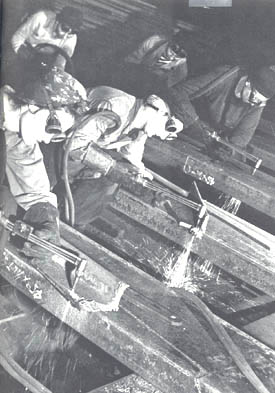
During WWII women workers welded armor plating with acetylene torches. Unless they fight against it, they can easily become manly
|
The opposite is also true. The feminist movement took the woman out of the house, insisted that she go everywhere, and do things that normally men should do – studies, business activities with the obsessive pursuit of a profit in everything.
The first thing that is contrary to the nature of the woman in this process is that she loses her purity. In times past, even while women were much more modestly dressed, a lady never used to leave the house without a companion: another lady, a child, a servant. Why? To protect her purity. It was not because she was under suspicion of meeting with a man and falling into sin, but rather to guard the precious treasure of her purity and give public testimony of that. She needed to feel this protection because her nature is delicate and the treasure of her purity is priceless.
Today, on the contrary, women go everywhere and that sense of purity has disappeared in countless families. Even when they are not having illicit meetings or committing bad actions, the fact that they go out by themselves without any companion opens the door for true or imaginary suspicions, and her reputation may suffer. These bad consequences were wisely avoided in the past because of the good protocol in place for women. How can children be morally well raised and psychologically balanced when there is a suspicion regarding the purity of their mother? How can a woman be respected when she takes no care to preserve her reputation? This confidence of her children and the respect of society are indispensable for a woman to develop her personality properly.
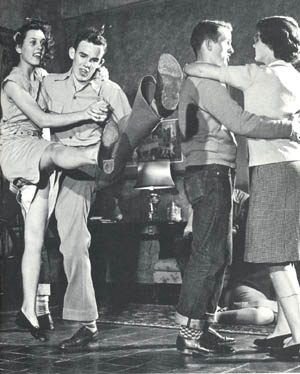
Liberty to go everywhere brings as a consequence the loss of a woman's good reputation
|
Then came the studies and careers for women. I am not saying that women should not study. But I think that they should choose studies proper to their nature. I am also not saying that, when it is an imperative necessity, women should not work. If it is a necessity, they should, but they should always be fighting to avoid assuming the manly characteristics of the workplace that would distort their feminine nature. As soon as there is no longer a necessity, she should abandon that work.
All these considerations regarding the delicacy of women do not mean that I think that women are meant to be only sentimental, without any exercise of reason. Women, like men, are rational creatures. Therefore, they should be persons of principles, like the strong woman of Scriptures. Like St. Teresa of d’Avila who often ended letters to her religious daughters with this advice: “Hijas mias, no sed mujericas” [My daughters, do not be foolish little women].
These are some considerations inspired by the life of St. Macrina, a woman of principles who was called Macrina the Great by her saintly brothers.


  | | Prof. Plinio Corrêa de Oliveira | |
The Saint of the Day features highlights from the lives of saints based on comments made by the late Prof. Plinio Corrêa de Oliveira. Following the example of St. John Bosco who used to make similar talks for the boys of his College, each evening it was Prof. Plinio’s custom to make a short commentary on the lives of the next day’s saint in a meeting for youth in order to encourage them in the practice of virtue and love for the Catholic Church. TIA thought that its readers could profit from these valuable commentaries.
The texts of both the biographical data and the comments come from personal notes taken by Atila S. Guimarães from 1964 to 1995. Given the fact that the source is a personal notebook, it is possible that at times the biographic notes transcribed here will not rigorously follow the original text read by Prof. Plinio. The commentaries have also been adapted and translated for TIA’s site.
|
Saint of the Day | Home | Books | CDs | Search | Contact Us | Donate

© 2002- Tradition in Action, Inc. All Rights Reserved
|
 |

|